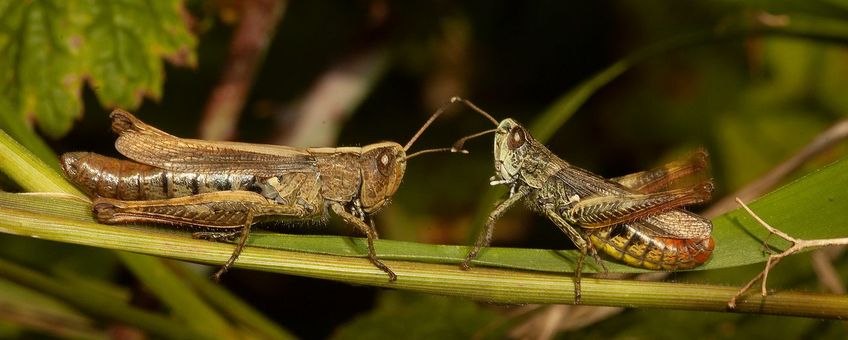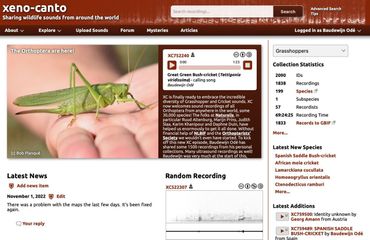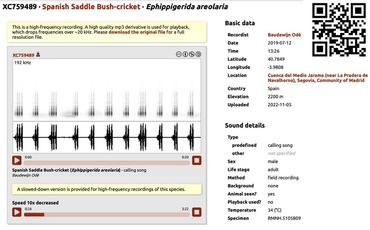
Grasshopper sounds now available for everyone on Xeno-canto
EIS Kenniscentrum Insecten, Naturalis Biodiversity Center, Xeno-Canto The website xeno-canto.org is well known by people who record bird sounds or want to learn more about them. The website contains recordings of sounds of about 10.000 bird species. The species list of the 30.000 grasshopper – Orthoptera – species has now been added to the website. A substantial part of all grasshoppers produce sounds. 1500 sound recordings of more than 170 European species have already been added. Bob Planqué of Xeno-canto adds with a smile: “But we expect that the number of recordings will rise quickly.”
The website xeno-canto.org is well known by people who record bird sounds or want to learn more about them. The website contains recordings of sounds of about 10.000 bird species. The species list of the 30.000 grasshopper – Orthoptera – species has now been added to the website. A substantial part of all grasshoppers produce sounds. 1500 sound recordings of more than 170 European species have already been added. Bob Planqué of Xeno-canto adds with a smile: “But we expect that the number of recordings will rise quickly.”
Inaudible sounds made audible
Up until now only compressed formats – mp3 – could be uploaded. The technique of the website is updated, and all relevant recent formats can be uploaded, like WAV-files. Recordings can be saved in standard (CD) quality of 44.1 kHz sampling frequency, but also in high resolution, for example 384 kHz sampling frequency. This makes it possible to upload and play sounds above 20 kHz, which are inaudible for the human ear. More so than in bird song, these ultrasound sounds are important in grasshopper songs. Especially in bush-crickets, the loudest part of the song is ultrasound. “We make the ultrasound sounds audible by playing them ten times slower,” Baudewijn Odé explains. “When playing the song, you see the oscillogram, a sound wave in time, and a spectrogram, showing the pitch of the sound in time. The location and more details of the recording are also displayed.”


A singing Ephippigerida areolaria, a Spanish bush-cricket that produces sound by rubbing its wings together. On the right the recording of a Spanish bush-cricket on Xeno-canto with a spectrogram (above) and oscillogram (below). The QR code on the top right leads directly to the recording on Xeno-canto (Source: Roy Kleukers, Xeno-canto)
Sound experts
By sharing sound recordings, we can learn how to learn how to recognize the songs of the different species. This is an important tool in species recognition in grasshoppers. Baudewijn: “So sound is an ideal way to recognize species in the field.” The website is equipped to accommodate distribution records, like in iNaturalist or Observation, but is specialized in sharing sound recordings. The sound recordings with locality information are shared with GBIF. Furthermore Xeno-canto.org offers the possibility to upload unidentified sound recordings. Specialists from the Xeno-canto community can help to identify the species.
A compilation of singing grasshoppers (Source: EIS Kenniscentrum Insecten)
Hopes for the future
“We expect that not only grasshopper enthusiasts will help in the growth of the collection of sound recordings; we think that recordists of other animal groups will take the opportunity to expand their horizon,” Bob Planqué says. As soon as the collection is large enough, it will be possible to develop automatic recognition software for grasshopper sounds. “Hopefully we can recognize all kind of species in all kinds of recordings. But that will be something for the future.”
More information
- Learn and share sound recordings of birds and grasshoppers via de the website Xeno-canto
- This project was made possible by grasshopper specialists from the Netherlands, Naturalis Biodiversity Center, financial support of NLBIF, the national node of GBIF - Global Biodiversity Information Facility and a contribution of the Orthopterists’ Society
Text: Baudewijn Odé en Roy Kleukers, EIS Kenniscentrum Insecten; Sander Pieterse, Naturalis en Xeno-canto; Bob Planqué en Willem-Pier Vellinga, Xeno-canto
Photos: Roy Kleukers (lead picture: singing male of the White-clubbed grasshopper Gomphocerippus rufus, near a female); Xeno-canto
Film: EIS Kenniscentrum Insecten
